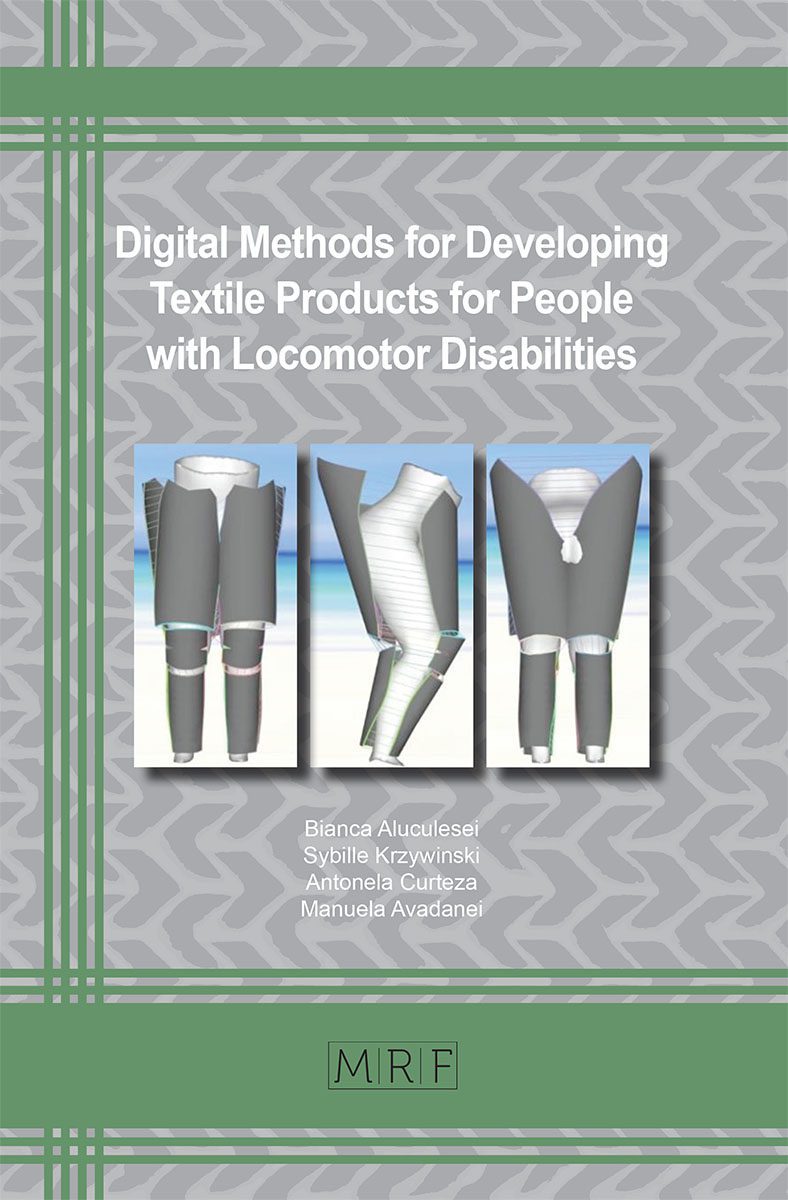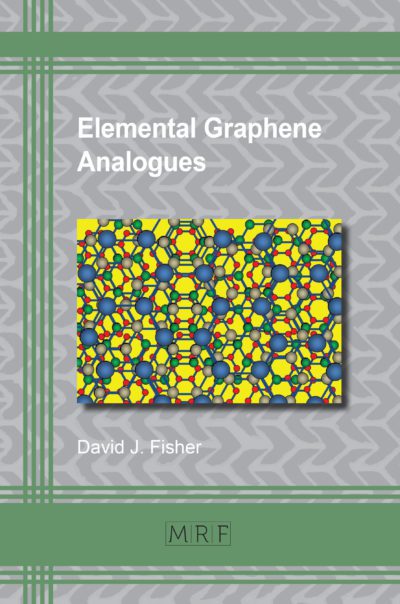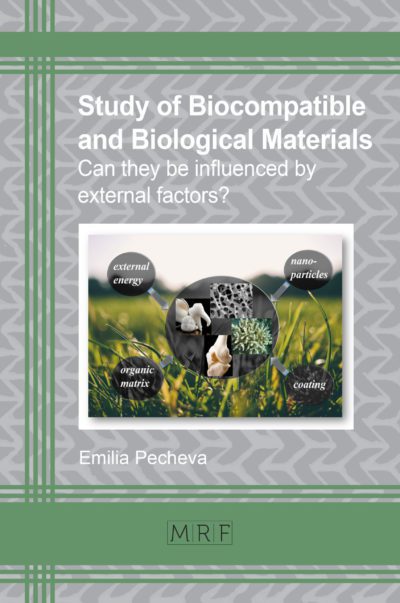Digital Methods in Developing Textile Products for People with Locomotor Disabilities
Bianca Aluculesei, Sybille Krzywinski, Antonela Curteza, Manuela Avadanei
Materials Research Foundations Vol. 110
Publication Date 2021, 144 Pages
Print ISBN 978-1-64490-154-0 (release date October 2021)
ePDF ISBN 978-1-64490-155-7
DOI: 10.21741/9781644901557
In the United States, there are 3-4 million wheelchair users, with the number steadily increasing. This book focuses upon the design of garments for wheelchair-users by considering the shape of the body while in the sitting position, the needs of the user (functionality, fashionability, ease-of-use, affordability, safety), as well as the characteristics and properties of the materials used. The book references 186 original resources and includes their direct web link for in-depth reading.
Keywords
Disabilities, Clothing for Disabled Persons, Wheelchair Users, Paraplegia, Functional Clothes, Kinematic Model, Scanning Procedure, 2D-3D/ 3D-2D Virtual Prototype, Body Posture Simulation, Virtual Pattern Making, Garment Fit Simulation
flyer
Table of contents
Introduction v
1. Disabilities: Classifications and Clothing Needs 1
1.1 Disability 1
1.1.1 Definitions and classifications 1
1.1.2 Physical disabilities 4
1.1.3 Acquired disabilities – Spinal cord injury 6
1.1.4 Types of paraplegia – body morphology and medical problems 7
1.2 Functional clothing for persons with special needs 9
1.3 Needs and demands of wheelchair-users with regard to clothing 10
1.3.1 Aesthetic demands 11
1.3.2 Functional demands 11
2. Garment Design Methods for Wheelchair-Users 14
2.1 Anthropometric measurements 14
2.1.1 Traditional measuring methods 17
2.1.2 Scanning methods 18
2.2 Measurement techniques for wheelchair-users 22
2.2.1 Traditional method 22
2.2.2 Three-dimensional scanning procedure 25
2.2.3 Kinematic body-model 27
2.3 Computer-aided design systems 35
2.3.1 2D-3D virtual prototyping of garments 36
2.3.2 3D-2D virtual prototyping of garments 37
2.3.3 Conventional garment construction for wheelchair users 38
2.3.4 3D virtual prototyping of garments for wheelchair-users 39
3. Proposed Methodology for Body-Scanning 44
3.1 Three-dimensional scanning procedure 45
3.1.1 Scanners 46
3.1.2 Scanning procedure for the standing position 48
3.1.3 Scanning procedure for the sitting position 53
3.1.4 Scanning procedure for a wheelchair-user 65
3.2 Body-posture animation using a kinematic template model 69
3.2.1 Adaptation of the kinematic template model to scan data 70
3.2.2 Animation of the kinematic model to obtain various positions of the lower body 73
3.2.3 Body-posture simulation using scan data obtained using the ViALUX BodyLux®. zSnapper® 74
3.2.4 Comparison between kinematic body-model and scan data 77
4. Virtual pattern-making for wheelchair-users 82
4.1 3D-to-2D virtual prototyping 83
4.1.1 The construction of tight-fitting pants on a defined body position 87
4.1.2 Fit simulation for the tight-fitting pants model 92
4.2 2D-3D virtual prototyping 101
4.2.1 The construction of basic pants patterns and fit simulation 101
4.2.2 Modification of the basic pants patterns 103
4.2.3 Fit simulation of the modified basic pants 109
4.3 Designing a pair of pants for a wheelchair-user 110
Conclusions 118
References 119
Abbreviations 135
About the Authors 136
Google Preview
About the authors
Bianca Aluculesei is a textile engineer, working in the clothing industry since 2013. In 2014 she decided to enter the research field and she began the doctoral studies willing to analyse what necessities the paraplegic persons have, regarding their clothing. In 2019, after a fruitful collaboration between The “Gheorghe Asachi” Technical University of Iasi, from Romania, and the Technical University of Dresden, from Germany, she finished her PhD dissertation under the supportive guidance of her supervisors. Her doctoral thesis, “Researches on the implementation of new digital methods for the development of textile products for people with locomotor disabilities.” provides new methods for the digital development of textile products for wheelchair users.
Sybille Krzywinski studied at Technischen Universität Dresden, Germany, in the area of Textile Technology, and her habilitation theses was entitled “3D product development for garments and technical textiles by means of CAE”. She is currently Professor dr. eng. habil. at Technical University of Dresden, Institute of Textile Machinery and High Performance Material Technology, Germany. Between 2016 and 2019 she was an acting director at the chair of “Ready-made Technology”, and from 2019 she is the scientific director at the chair “Development and Assembly Technology for Textile Products”. She taught in areas of Spinning, Weaving, Ready-made Technology, Design and Construction/CAD, 3D-CAD-Applications – Virtual product development, Digital process chains, Technical Textiles. She published more than 230 research articles in professional journals, and presented lectures at national and international conferences. Professor Sybille Krzywinski has coordinated, developed and managed numerous public funded research and industrial projects in the field of aircraft and vehicle construction, sports and medical textiles/garments, and conventional textiles/clothing. Since 2016 she is Equal Opportunity Commissioner at the Faculty of Mechanical Engineering. She is also reviewer for refereed textile journals.
Antonela Curteza graduated the Faculty of Textile and Garment Engineering from the “Gheorghe Asachi” Technical University of Iasi, Romania, and holds a Doctorate degree in Functions and Comfort of Clothing. She is Professor dr. eng. habil at the Knitting and Clothing Engineering Department within the Faculty of Industrial Design and Business Management. She has initiated and conducted many research and teaching activities focused mainly on: design, clothing comfort and functions, smart and functional textile products, sustainable fashion. Professor Antonela Curteza has been a PhD supervisor and scientific coordinator of 15 PhDs in the field of Industrial Engineering. She is author and co-author of 12 books having garment design, functions and comfort as main subjects. She has authored more than 170 articles published by international and national journals, and international conference proceedings, from which 55 are ISI certified. She took part in 21 national and 9 international research projects; in 16 of them she held the position of coordinator or partner manager. The main current research work and interests are: clothing comfort and functions, sustainable development in fashion and design, functional textile products for people with special needs and, protective clothing.
Manuela Avadanei is an Associate Professor at The “Gheorghe Asachi” Technical University of Iasi-Romania, Faculty of Industrial Design and Business Management, with a PhD degree in the field. She is an expert in the field of anthropometry applied in textile engineering, with an emphasis on obtaining, analysing and interpreting information regarding the shape of the human body, which is subsequently employed in the ergonomic pattern making process of clothing (fashion products, protective or medical equipment, sportswear, etc.). She has also focused on the pattern making process for complex-shaped and highly personalized apparel products, which involves 2D and 3D IT tools (specialized CAD systems for the clothing industry), based on the customer’s needs and requirements, as part of a digitalized fashion and clothing industry. She continues her research and academic activity in pattern making by exploring new ideas or techniques for developing ergonomic garment products adapted to different demands, body shapes, and purposes (fashionable, sportive or protective). The author is also actively involved in research projects and in publishing articles in the aforementioned areas.

































